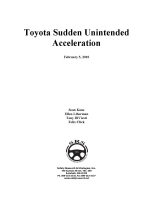Last week, Ed Towns, Chairman of the U.S. House Committee on Oversight and Government Reform went to town on Toyota, asking five very pointed questions about the automaker’s “Books of Knowledge,” compendiums purportedly containing, among other things, damning information about the automakers acknowledgement of design issues and countermeasures, by component and vehicle. References to these so-called Books of Knowledge appeared in documents produced under a committee subpoena from former Toyota counsel, Dimitrios Biller. In a letter to Yoshimi Inaba, CEO of Toyota Motor North America, Towns asked him to respond to e-mails such as this June 2005 correspondence to Toyota executive Webster Burns, regarding the Greenburg SUA lawsuit:
“When this lawsuit was threatened, no one was surprised. This issue [sudden unintended acceleration] had been the subject of a number of meetings and the exchange of a number of documents between TMS and TMC, (did anyone ever gather and organize all those documents and memorialize the “meetings”? If so, were [sic] are the documents and information about the meetings?) [emphasis indicates Biller’s comments] and the possibility of a class action lawsuit was used as one way to try to get TMC to work on a series of proposed countermeasures.” Continue reading
